.
Explore Bradford on Avon:
St Margaret’s Street, western side
Bradford on Avon, Wiltshire
.
St Margaret’s Street runs from the southern end of the Town Bridge. It formerly continued on the line that is now called Frome Road, but nowadays it turns off left behind Hall’s Almshouses and other buildings along what was Besoar Street. It takes its name from a now lost medieval St Margaret’s Hospital, which was founded in 1235.
.
Click on the thumbnail pictures to see a bigger view.
Western side, from the Bridge
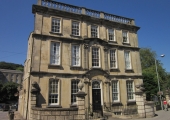 Westbury House is an early 18th century house of three storeys and basement. It is in a baroque style found in Bradford (Druce’s House, Church Street), Bath, Bristol and Trowbridge in which the entrance feature is repeated on upper floors. It was the birthplace of Richard Bethell, Lord Westbury (1800-1873) who was Attorney General and Lord Chancellor. It was the offices of Bradford Urban District Council from 1911 to 1974. The Council made Westbury Garden into a public park, which contains the War Memorial.
Westbury House is an early 18th century house of three storeys and basement. It is in a baroque style found in Bradford (Druce’s House, Church Street), Bath, Bristol and Trowbridge in which the entrance feature is repeated on upper floors. It was the birthplace of Richard Bethell, Lord Westbury (1800-1873) who was Attorney General and Lord Chancellor. It was the offices of Bradford Urban District Council from 1911 to 1974. The Council made Westbury Garden into a public park, which contains the War Memorial.
 St Margaret’s Hall was an early 19th century factory where wool and woollen cloth were dyed under the ownership of members of the Spackman, Timbrell and Moore families until 1903. In 1917 it was converted into the Alexander Cinema, with the addition of the present foyer. It was taken over by the Urban District Council in 1959 and refurbished as a public hall.
St Margaret’s Hall was an early 19th century factory where wool and woollen cloth were dyed under the ownership of members of the Spackman, Timbrell and Moore families until 1903. In 1917 it was converted into the Alexander Cinema, with the addition of the present foyer. It was taken over by the Urban District Council in 1959 and refurbished as a public hall.
.
 St Margaret’s House is a five-bay very early 18th century mansion with crossed transom and mullion windows and a later porch on tuscan columns. A plain extension was added to the right, linking to a half-hipped building with venetian window. Bradford Rowing Club owned it from 1973 and developed a further extension, despite a bad fire. When the Club could not afford to carry on there, it became a public house, The Riverside Inn, which closed in 2013.
St Margaret’s House is a five-bay very early 18th century mansion with crossed transom and mullion windows and a later porch on tuscan columns. A plain extension was added to the right, linking to a half-hipped building with venetian window. Bradford Rowing Club owned it from 1973 and developed a further extension, despite a bad fire. When the Club could not afford to carry on there, it became a public house, The Riverside Inn, which closed in 2013.
.
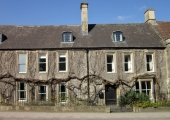 The Prebend House, 47, was built on part of Bradford that was given to Bristol Cathedral by Henry VIII in 1543 and was the manor house of the Prebendal, or Rectory Manor that held land all over the ancient parish of Bradford, especially in Winsley. The Dean & Chapter of Bristol sold off its remaining property in the 19th century. The present building, externally at least, is of the early 18th century and seems to be a conversion from three houses.
The Prebend House, 47, was built on part of Bradford that was given to Bristol Cathedral by Henry VIII in 1543 and was the manor house of the Prebendal, or Rectory Manor that held land all over the ancient parish of Bradford, especially in Winsley. The Dean & Chapter of Bristol sold off its remaining property in the 19th century. The present building, externally at least, is of the early 18th century and seems to be a conversion from three houses.
.
Number 46, with a well-preserved façade from the end of the 18th century, was for many years a doctor’s surgery and home.
Number 45, recently Cloudberry, previously Rowland’s, number 45, was the shop of a succession of stationers and newsagents through much of the 19th and 20th centuries.
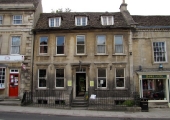 Salvat’s Coffee House, 44, is of five narrow bays and two floors, cellar and attic with three dormers. It is a rebuild of the 18th century which preserves some earlier features.
Salvat’s Coffee House, 44, is of five narrow bays and two floors, cellar and attic with three dormers. It is a rebuild of the 18th century which preserves some earlier features.
.
.
.
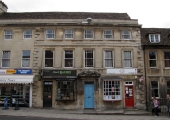 Number 43, bakery and barber, is an 18th century Georgian house with curved open pediment doorway. The two shops have been opened in the ground floor by extending the far windows into doors and the insertion of bow windows. The building was derelict in 1974.
Number 43, bakery and barber, is an 18th century Georgian house with curved open pediment doorway. The two shops have been opened in the ground floor by extending the far windows into doors and the insertion of bow windows. The building was derelict in 1974.
.
.
Number 42, The Grocery Basket, has a plain Georgian front that continues the cornice and parapet of the house next door. It was once Keates’ Central Garage and, in the place of the plate glass window, there was a vehicle entrance right through the front. When the garage moved to Frome Road it was converted into a shop. The space to the left is the site of a row of two or three small 17th century houses. They stood forward of the 18th century building line and were demolished in 1935 to widen the road.
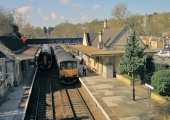 The Railway Station was built by the Wilts, Somerset & Weymouth Railway in 1848, but the line itself was not made until 1857. It is one of the best-preserved of this style of station that was designed by the Great Western Railway and so it often features in books on railway architecture. Trains from here run to Bath, Bristol and Cardiff; to Salisbury, Southampton, Portsmouth and Brighton; to Yeovil and Weymouth; London Paddington via Newbury and Reading; London Waterloo via Salisbury and Basingstoke. Cross Country trains use the line, as do occasional steam excursions.
The Railway Station was built by the Wilts, Somerset & Weymouth Railway in 1848, but the line itself was not made until 1857. It is one of the best-preserved of this style of station that was designed by the Great Western Railway and so it often features in books on railway architecture. Trains from here run to Bath, Bristol and Cardiff; to Salisbury, Southampton, Portsmouth and Brighton; to Yeovil and Weymouth; London Paddington via Newbury and Reading; London Waterloo via Salisbury and Basingstoke. Cross Country trains use the line, as do occasional steam excursions.
.


